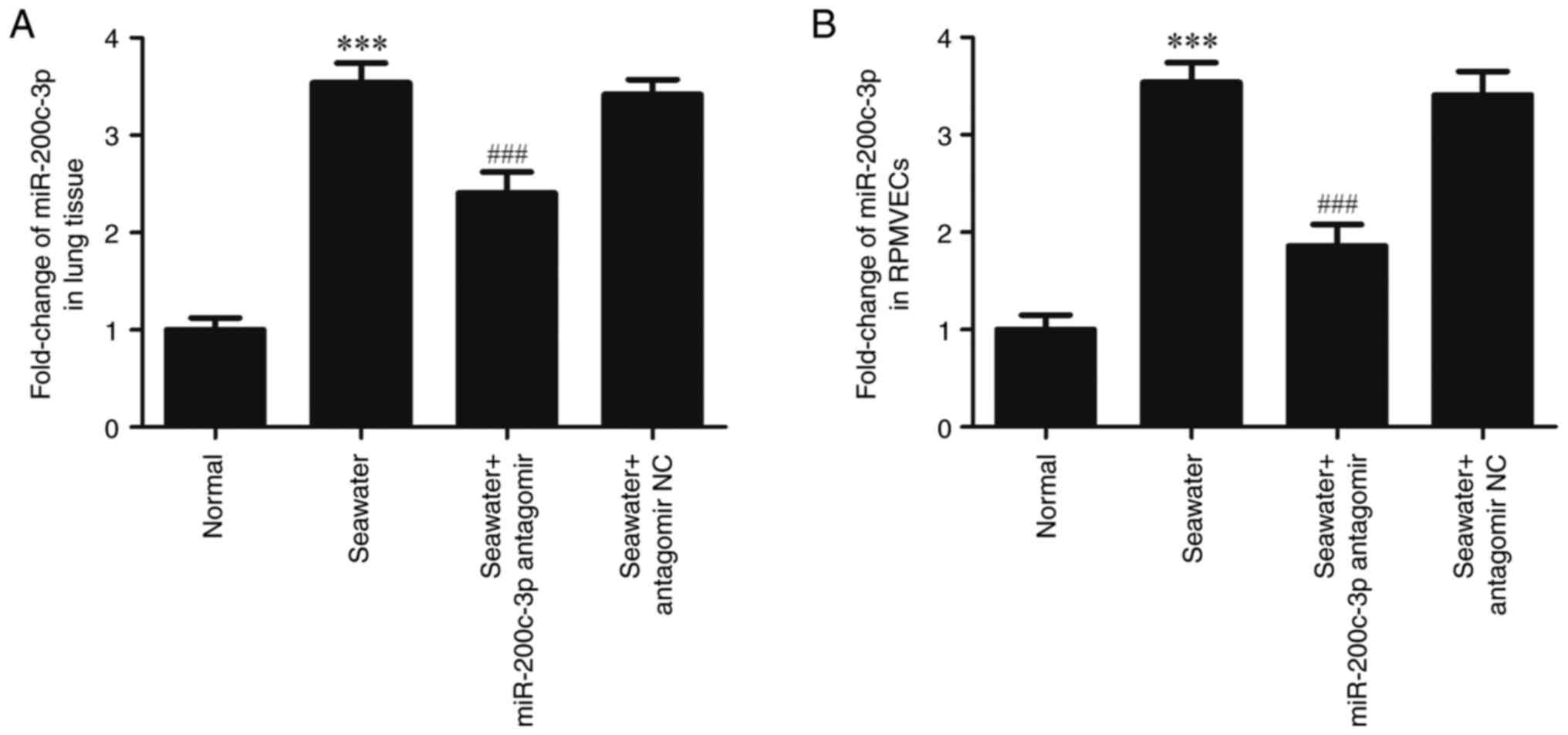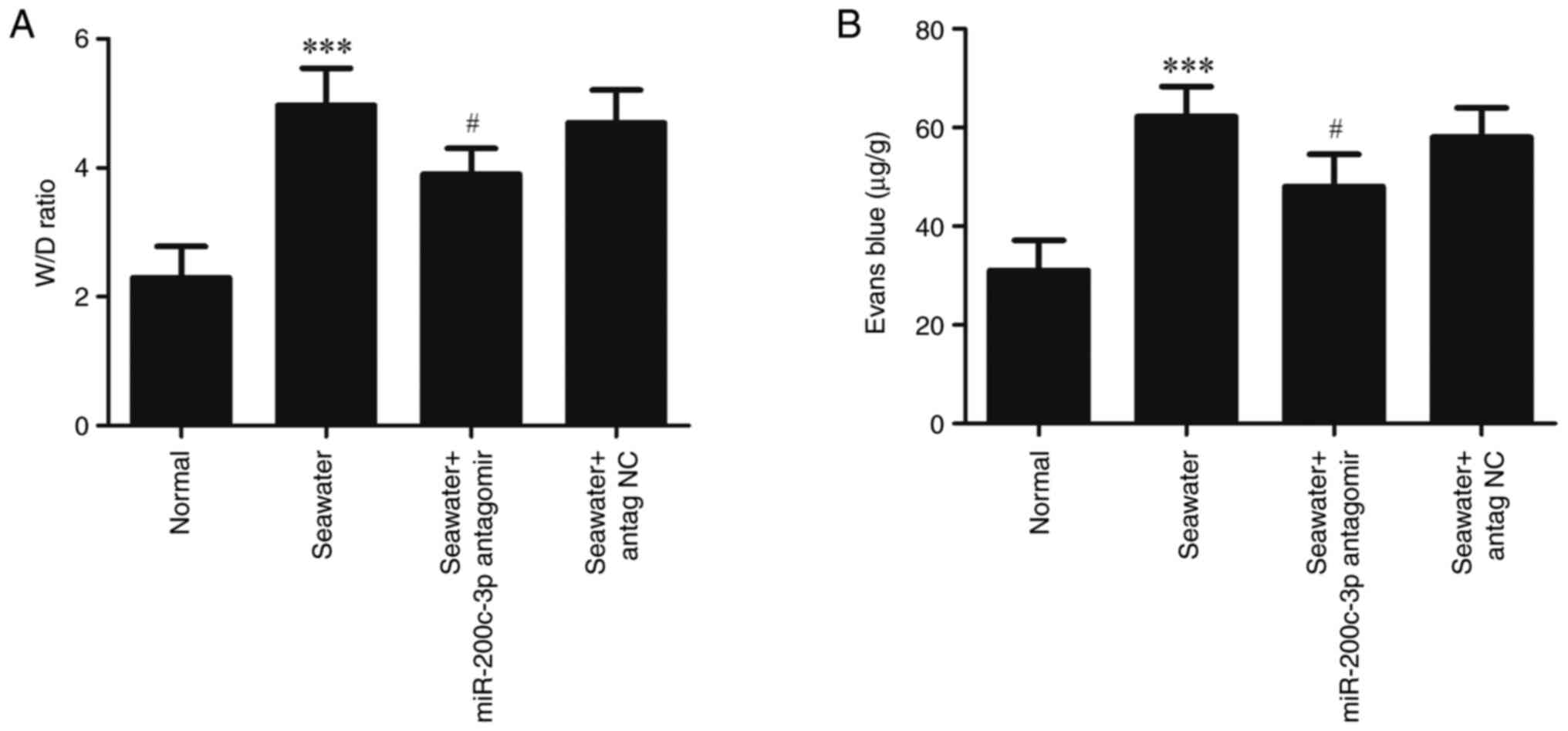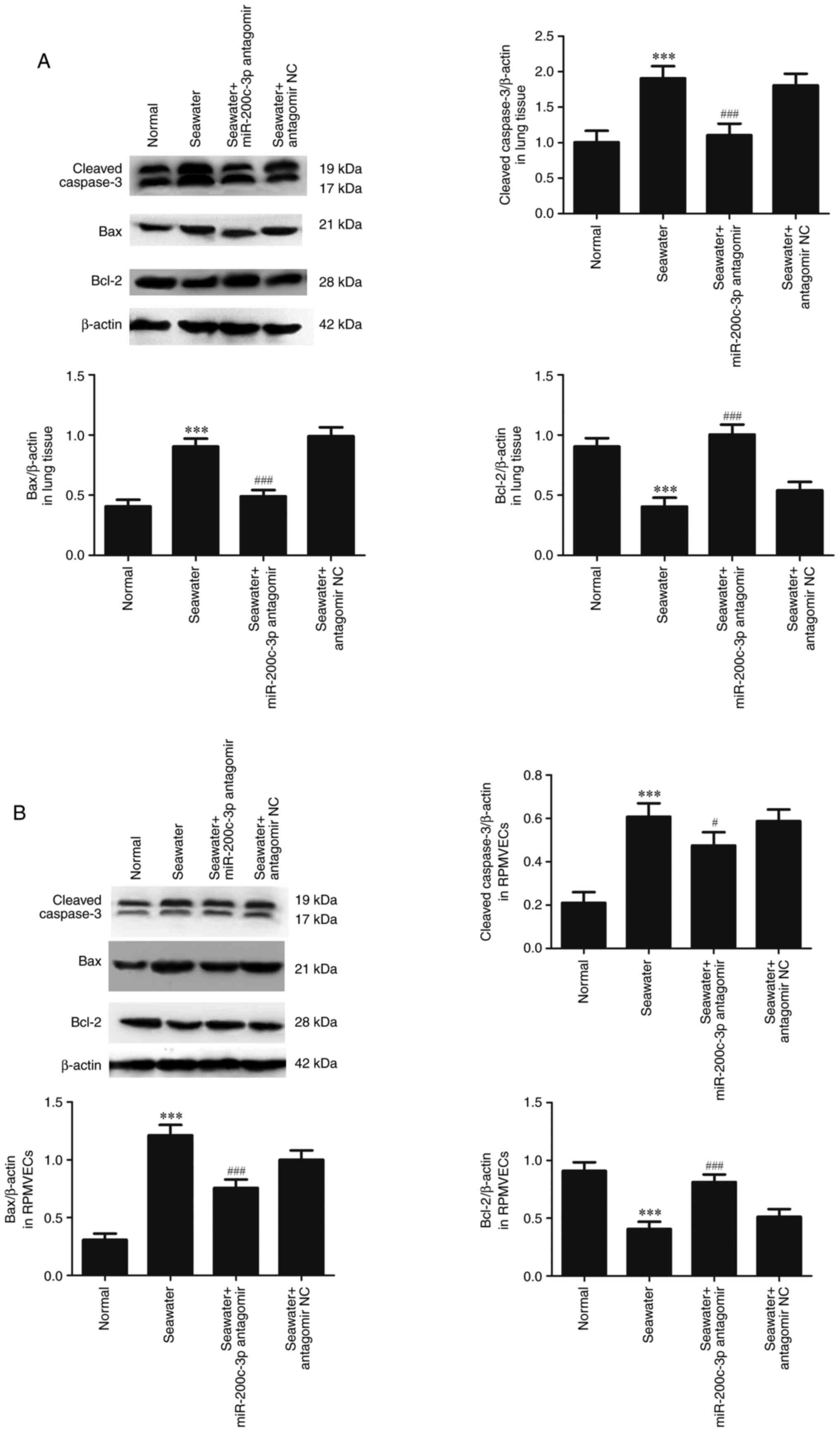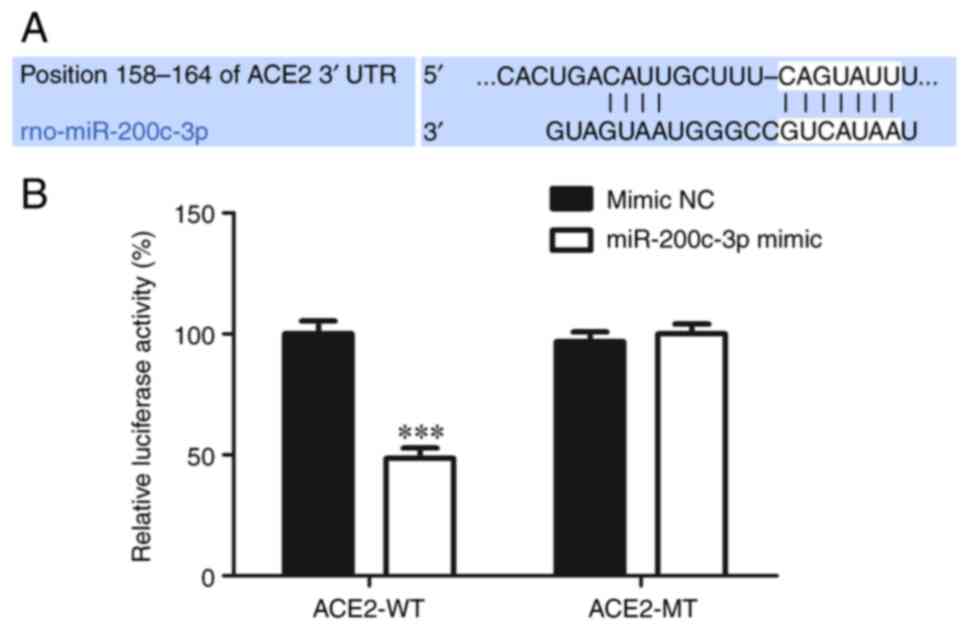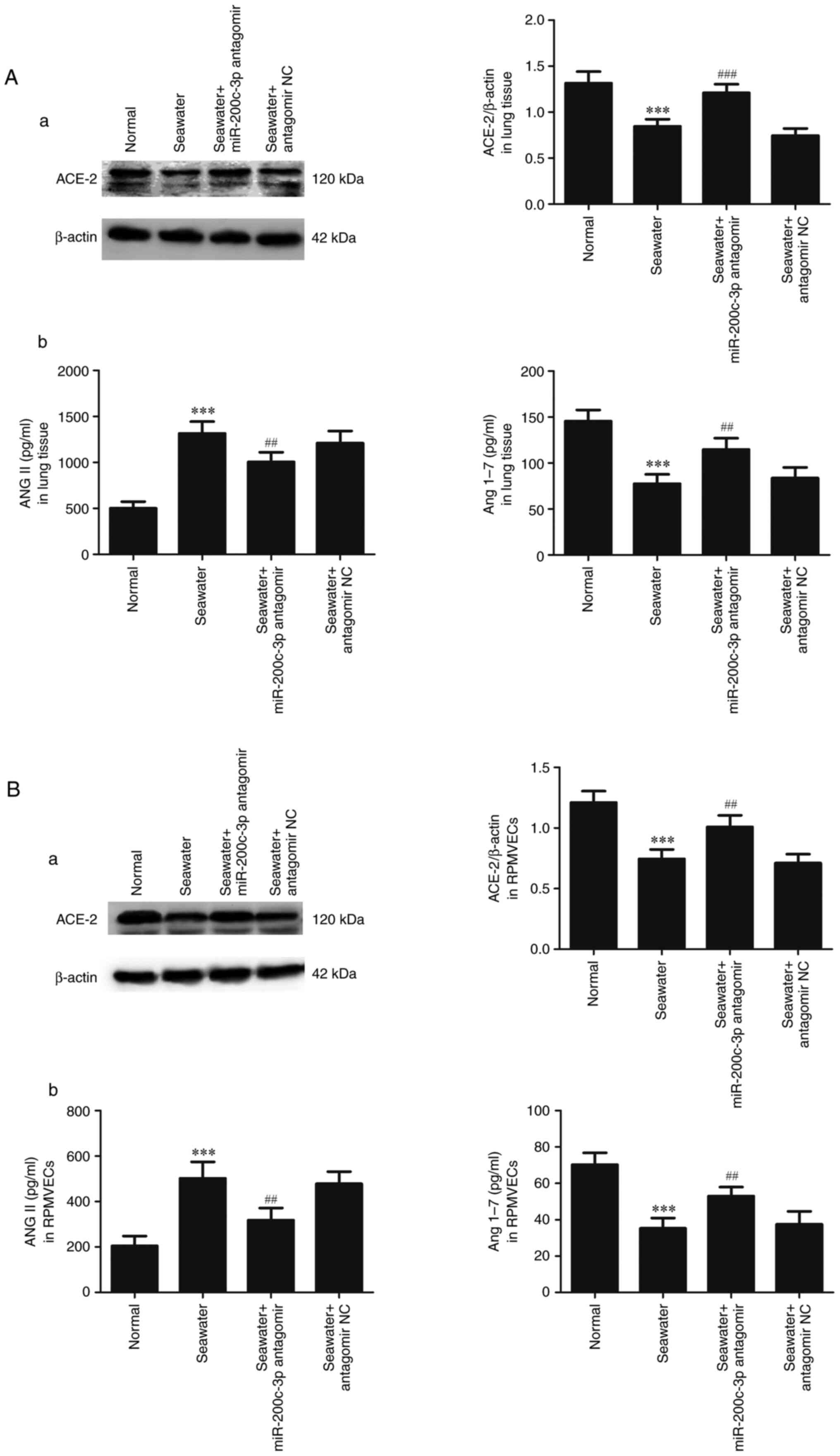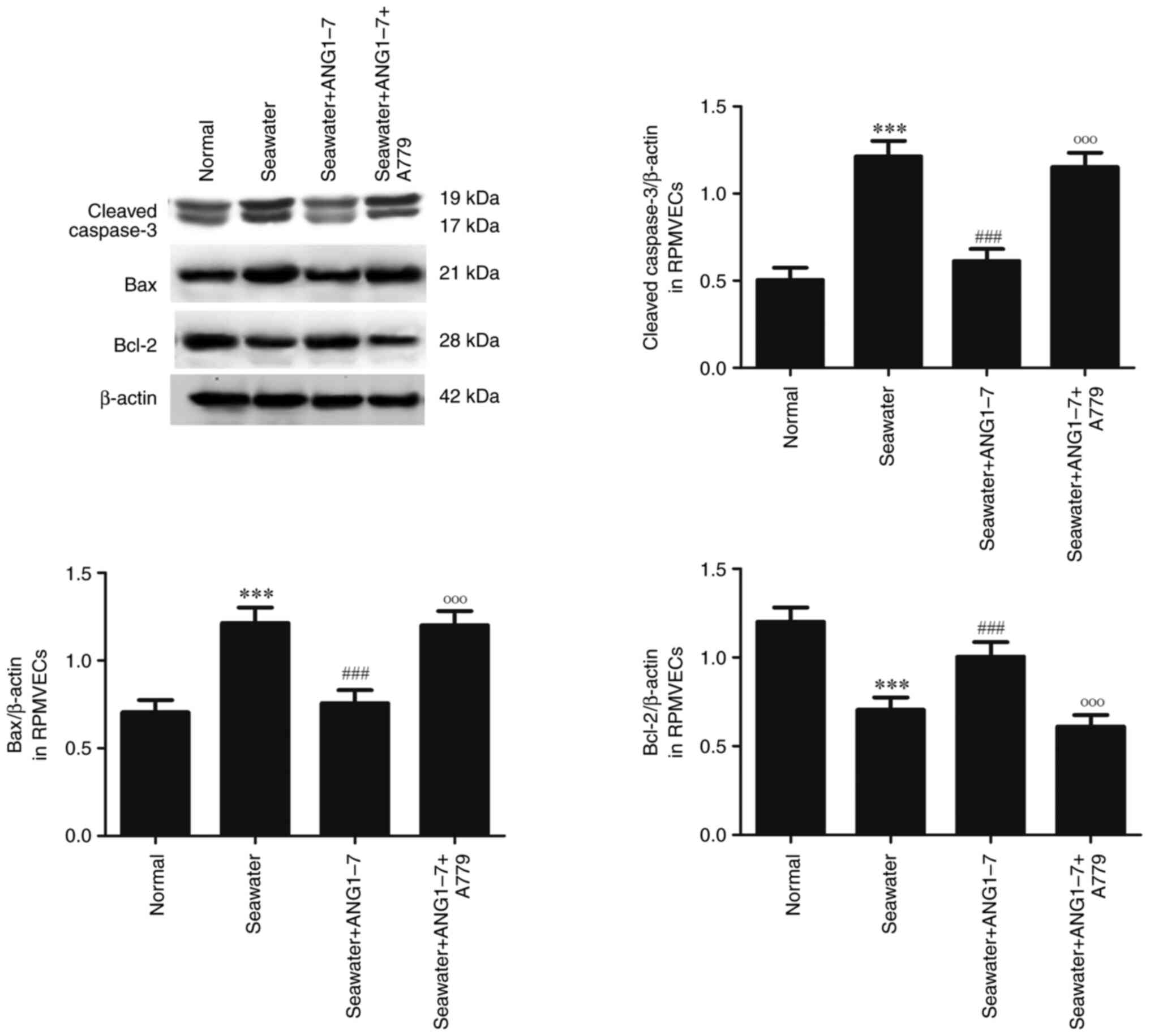MicroRNA‑200c‑3p regulates seawater‑induced acute lung injury via ANGII and ACE2/ANG1‑7 pathways
- Authors:
- Published online on: October 30, 2023 https://doi.org/10.3892/etm.2023.12281
- Article Number: 582
Abstract
Introduction
Seawater drowning is a main cause of outdoor death all over the world. Seawater aspiration can lead to acute lung injury (ALI) (1-3). Our previous study found that inflammatory cells can infiltrate in alveolar after the pulmonary microvascular endothelial cells injured and then the edema fluid forms in alveolar cells (4). In addition, seawater aspiration induced apoptosis of endothelial cells is a major cause of endothelial barrier injury (5-7).
In alveolar endothelial cells, studies have confirmed that there is a local angiotensin (ANG) system existing (8,9). This system contain ANGII and its counter regulatory axis angiotensin converting enzyme (ACE)-2/ANG1-7/Mas (receptor of ANG1-7). The local ANG system [ACE-2/ANG1-7/Mas axis and ANGII/angiotensin II receptor type 1 (AT1)] play an important role in apoptosis (10-13). AT1 inhibitor can decrease apoptosis of alveolar epithelial cells in bleomycin-induced pulmonary fibrosis. However, the ACE-2/ANG1-7/Mas axis shows significant anti-apoptotic effects in pulmonary fibrosis (14-17).
MicroRNAs are a class of small noncoding RNAs. Previous studies have revealed that miR-200c-3p is a biomarker for predicting the treatment outcome and mortality in sepsis-induced ALI (18,19). In addition, previous study defined miR-200c-3p as an endogenous inhibitor of ACE2 (19,20). However, its role and underlying mechanism in the seawater aspiration-induced ALI remain to be elucidated. The present study aimed to clarify the effects of miR-200c-3p/ACE2/ANG1-7 axis on seawater aspiration induced ALI.
Materials and methods
Animals
Sprague-Dawley (SD) rats (male, 5-7 weeks old; 200±20 g; n=32) were provided by Animal Center of Fourth Military Medical University. The rats were kept in a temperature-controlled house (temperature 20-26˚C; humidity 50-60%) with free access to standard laboratory diet and water ad libitum and a 12-h light/dark cycle. All the animal experiments were approved by the Animal Care and Use Committee of the Fourth Military Medical University (approval no. 2023-66378) and in accordance with the Declaration of the National Institutes of Health Guide for Care and Use of Laboratory Animals (Publication No. 85-23, revised 1985) (21). First, rats were anesthetized by pentobarbital sodium (50 mg/kg intraperitoneally). Then a 1 cm syringe was gently inserted into the trachea until 1.5 cm above the carina after exposing the trachea. Next, seawater (4 ml/kg) was instilled into the lung with steady speed in 4 min. Rats were intravenously treated with miR-200c-3p antagomir (80 mg/kg/day) or the negative controls (antagomir negative control and antagomir NC for miR-200c-3p antagomir; synthesized by Sangon Biotech Co., Ltd.) for 3 consecutive days before the seawater operation. After 4 h of seawater stimulation, the rats were exsanguinated by aortic transection (4). Then, thorax was rapidly opened and lungs were processed in the manner described below. Each group (Normal group; Seawater group; Seawater + miR-200c-3p antagomir group; and Seawater + antagomir NC group) contained 8 rats.
Drug and reagents
Seawater (osmolality 1300 mmol/l, pH 8.2, SW 1.05, NaCl 6.518 g/l, MgSO4 3.305 g/l, MgCl2 2.447 g/l, CaCl2 1.141 g/l, KCl 0.725 g/l, NaHCO3 0.202 g/l, NaBr 0.083 g/l) was prepared according to the major composition of the East China Sea provided by the Chinese Ocean Bureau.(https://www.nmdis.org.cn/). ELISA kits for ANGII (cat. no. DANG20) and ANG1-7 (cat. no. 1562/1) were obtained from R&D Systems. ANG1-7 and A779 (Mas antagonist) were purchased from GenScript. AT1 antagonist saralasin (SAR) was purchased from MilliporeSigma. Anti-cleaved-caspase3, anti-Bax, anti-Bcl-2, anti-ACE-2 and anti-CD31 antibodies were purchased from Cell Signaling Technology, Inc. Anti-β-actin antibody was purchased from Santa Cruz Biotechnology, Inc. The binding relationship of miR-200c-3p and ACE2 was determined from TargetScan (https://www.targetscan.org/vert_80/).
Lung wet/dry (W/D) ratios
Lung tissue of the same part (the whole right lung) of each rat was taken and the wet weight of the lung tissue was immediately weighed after wiping off the blood stains. The lung tissue sample was placed in a 50˚C drying oven for 72 h to constant weight and the wet-dry ratio calculated.
Evans blue dying
The Evans blue method was used to detect the permeability of lung tissue. Evans blue solution (20 mg/kg) was injected into the vein 30 min before anesthesia. After the experiment, normal saline was injected into the right ventricular lavage of rats until the left atrial outflow became clear. The middle lobe of the right lung was removed and dried at 60˚C for 72 h, then soaked in polyformaldehyde at room temperature for 24 h to extract the Evans blue. The concentration of Evans blue in the supernatant was measured at 620 nm by spectrophotometer. Evans blue (µg/g tissue) was calculated against the generated Evans blue standard absorbance curves.
Primary rat pulmonary micro vascular cells (RPMVECs) isolation, culture and treatment
First, the outer edges of fresh rat lung lobe were cut off. Then, 1.5 mm3 specimens of tissue cut from the lung outer edges were carefully plated into cell culture dishes (containing DMEM supplemented with 20% FBS, 25 µg/ml of endothelial cell growth supplement and 100 U/ml of penicillin-streptomycin; purchased from Sangon Biotech Co., Ltd.) at 37˚C with 5% CO2 and 95% air. The residue specimens were removed after 60 h. The cells were passed when a cell monolayer was achieved (Fig. S1A). In some of these experiments, RPMVECs were pre-treated with 50 µg/ml SAR, 10-7M ANG1-7 and 10-7M A779 for 2 h before stimulation. In addition, after incubated (37˚C) in the presence or absence of miR-200c-3p antagomir (100 nmol/l) for 48 h, seawater (0.25 ml per 1 ml total volume) were added to cells for 4 h.
Reverse transcription-quantitative (RT-q) PCR
Total RNA was extracted from the cells (7,000 cells/cm2) with TRIzol reagent (Invitrogen; Thermo Fisher Scientific, Inc.) according to the manufacturer's instruction. The purity and concentration of the RNA was analyzed using a NanoDrop ND-1000 spectrophotometer (Thermo Fisher Scientific, Inc.) at an optical density of 260/280 nm. Total RNA was reverse transcribed into cDNA using random primers from the Transcriptor First Strand cDNA Synthesis kit (Takara Biotechnology Co., Ltd.). Amplification and detection were carried out by using Bio-Rad My iQ detection system (Edinburgh Biological Science and Technology Development co. Berkeley, CA, USA). SYBR GREEN Mastermix (Takara Bio, Inc.) fluorophore was used for the qPCR. The thermocycling conditions were: Initial denaturation at 95˚C for 10 min; followed by 40 cycles of 95˚C for 10 sec, 60˚C for 60 sec and 95˚C for 15 sec. The relative expression levels were quantified using the 2-∆∆Cq method (13), using U6 as the controls to normalize the expression levels of mRNAs and miRNAs, respectively (4). The sequences of the rat miR-200c-3p primers (linear polyA tailed addition method) were 5'-TAATACTGCCGGGTAATGATG-3' (forward); 5'-CAGTGCAGGGTCCGAGGTCAGAGCCACCTGGGCAATTTTTTTTTTTVN-3' (reverse; universal). The sequences of the U6 primers were 5'-GGAACGATACAGAGAAGATTAGC-3' (forward); 5'-CAGTGCAGGGTCCGA GGTCAGAGCCACCTGGGCAATTTTTTTTTTTVN-3' (reverse; universal)
ELISA analysis
ANGII and ANG1-7 obtained from lung tissue supernatant and culture medium were detected with ELISA kits according to the manufacturer's protocol. The concentration of ANGII and ANG1-7 was detected in each sample by microplate reader at 450 nm.
Dual-luciferase reporter assay
RPMVECs were seeded into 24-well plates and after 24 h incubation the confluence reached 60-70%. Wild type (WT) 3'-UTR of ACE2 and mutant (MT) 3'-UTR of ACE2 reporter plasmids were constructed in advance. According to the manufacturer's instruction, cells were transiently co-transfected with miR-200c-3p mimics or NC mimics together with 0.1 µg reporter plasmids using Lipofectamine® 2000 (Invitrogen; Thermo Fisher Scientific, Inc.). After incubation at 37˚C for 48 h, Dual-luciferase Reporter Assay System (cat. no. E1910; Promega Corporation) was used to detect firefly and Renilla luciferase activities and imaged using GloMax 96 Microplate Luminometer (Promega Corporation).
Western blot analysis
Total protein was extracted from cells using RIPA lysis buffer (Beyotime Institute of Biotechnology). Proteins were quantified using the BCA method. The samples were extracted by centrifugation at 12,000 x g for 20 min at 4˚C. Then 30 µg proteins were boiled in loading buffer, separated by 10% SDS-polyacrylamide gels, electrotransferred to nitrocellulose membranes and washed with 5% non-fat milk in TBST for 1 h at 4˚C (0.1% Tween). The membrane was incubated overnight at 4˚C with rabbit monoclonal antibodies for β-actin (1:5,000 dilution; cat. no. sc-47778, Santa Cruz Biotechnology, Inc.), cleaved-caspase3 (1:1,000 dilution; cat. no. 9579 Cell Signaling Technology, Inc.), Bax (1:1,000 dilution; cat. no. 41162 Cell Signaling Technology, Inc.), Bcl-2 (1:1,000 dilution; cat. no. 4223 Cell Signaling Technology, Inc.), ACE-2 (1:1,000 dilution; cat. no. 92485 Cell Signaling Technology, Inc.). Following the primary antibody incubation, the membranes were washed with TBST and incubated with HRP conjugated secondary antibodies goat anti-rabbit (1:1,000; cat. no. GTX213110-01; GeneTex International Corporation) for 2 h at 4˚C. The membrane was incubated with the secondary antibody and the relative content of proteins were tested with chemiluminescent (ECL) detection system (Beyotime Institute of Biotechnology). The band intensity was analyzed using ImageJ (1.5.0) software (National Institutes of Health).
Immunofluorescence (IF) method
IF assays were conducted to determine the cellular location of CD31 protein expression (Fig. S1C). Cells were seeded on to cover slips at 5x104/ml density and then fixed in 4% paraformaldehyde (Beyotime Institute of Biotechnology) for 15 min at 37˚C, permeabilized using 0.1% Triton X-100 (Beyotime Institute of Biotechnology) for 20 min and blocked using 5% bovine serum albumin (MilliporeSigma) for 1 h at 37˚C. Heat-mediated antigen retrieval was performed with Tris/EDTA buffer (Gibco; Thermo Fisher Scientific, Inc.). IF was performed with CD31 (5 µg/ml; cat. no. 77699; Cell Signaling Technology, Inc.) antibody for 12 h at 4˚C in the dark, followed by incubation with Alexa Fluor 488 conjugated, goat anti-rabbit IgG (1:1,000; cat. no. Ab150077; Abcam.). A total of five fluorescence images were captured using a fluorescence microscope (Leica DMi8; Leica Microsystems GmbH) with different excitation wavelengths for the same field (Alexa Fluor 488 maximum emission is 518 nm).
Statistical analysis
All data were expressed with mean ± SD. The statistical significance of the differences between the groups was determined using GraphPad Pro Prism 6.0 (GraphPad Software; Dotmatics). Mann-Whitney U-test or one-way ANOVA was used to compare the differences between groups (Tukey's was used as a post hoc test). P<0.05 was considered to indicate a statistically significant difference. The binding relationship of miR-200c-3p and ACE2 were used Biological website TargetScan (https://www.targetscan.org/vert_80/).
Results
Effects of seawater stimulation on the expression of miR-200c-3p
As detected by RT-qPCR, the expression of miR-200c-3p was significantly upregulated both in lung tissue (Fig. 1A) and RPMVECs (Fig. 1B) following seawater stimulation. However, the expression of miR-200c-3p was inhibited following the miR-200c-3p antagomir (miR-200c-3p inhibitor) administration (P<0.001).
Effects of miR-200c-3p inhibitor on the seawater induced lung edema and vascular leakage in lung tissue
To evaluate lung edema and vascular leakage, the W/D weight ratios and leak index of Evans blue were measured (Fig. 2). Compared with the Normal group, seawater administration significantly increased the W/D ratios and Evans blue leakage (P<0.001). Administration of miR-200c-3p antagomir significantly suppressed the edema and vascular leakage.
Effects of miR-200c-3p inhibitor on apoptosis following seawater stimulation in lung tissue and RPMVECs
The capacity of miR-200c-3p inhibitor on apoptosis following seawater stimulation in lung tissue (Fig. 3A) and RPMVECs (Fig. 3B) was further assessed. Seawater administration promoted the expression of cleaved-caspase3 and Bax and decreased the expression of anti-apoptosis protein Bcl-2. However, pretreatment with miR-200c-3p antagomir significantly reduced the expression of cleaved caspase3 and Bax, and increased the expression of Bcl-2 both in lung tissue and RPMVECs.
ACE2 is directly targeted by miR-200c-3p
Biological website TargetScan (https://www.targetscan.org/vert_80/) revealed that miR-200c-3p could bind to ACE2 (Fig. 4A). Dual luciferase reporter gene assay was used to confirm this and the result showed that miR-200c-3p mimic clearly inhibited the luciferase activity of the reporter containing the WT 3'-UTR of ACE2 compared to mimic NC, However, the luciferase activity change was not detected in the MT 3'-UTR of ACE2 group (Fig. 4B), indicating that ACE2 was a direct target of miR-200c-3p.
Effects of miR-200c-3p inhibitor on expression of ACE2, ANGII and ANG1-7 in lung tissue and RPMVECs
To assess the capacity of miR-200c-3p inhibitor on the expression of ACE2, ANGII and ANG1-7 in lung tissue (Fig. 5A) and RPMVECs (Fig. 5B), ACE2 was measured by western blotting and ANGII and ANG1-7 were measured by ELISA kits. Compared with normal group, expression of ACE2, ANG1-7 were decreased and ANGII was significantly enhanced in seawater group both in lung tissue and RPMVECs. In addition, administration of miR-200c-3p antagomir significantly increased the expression of ACE2, ANG1-7 and inhibited the ANGII expression.
The effect of ANGII on the apoptosis following seawater stimulation in RPMVECs
AT1 antagonist SAR was used to explore the effect of ANGII on apoptosis (Fig. 6). Seawater administration promoted the expression of cleaved-caspase3 and Bax, and decreased the expression of anti-apoptosis protein Bcl-2. However, pretreatment with SAR significantly reduced the expression of cleaved caspase3 and Bax, and increased the expression of Bcl-2.
The effect of ANG1-7 on the apoptosis following seawater stimulation in RPMVECs
ANG1-7 and its receptor Mas antagonist A779 were used to explore the effect of ANG1-7 on the apoptosis (Fig. 7). Administration of ANG1-7 can inhibit the expression of cleaved caspase3 and Bax and increase the expression of Bcl-2 following seawater stimulation. However, adding A779 significantly promoted the expression of cleaved caspase3, Bax and inhibited the expression of Bcl-2 following seawater stimulation.
Discussion
The present study explored the role of miR-200c-3p in apoptosis of seawater aspiration-induced ALI. The results showed that expression of miR-200c-3p was significantly upregulated both in lung tissue and RPMVECs following seawater stimulation. Seawater stimulation promoted ANGII expression and decreased ACE-2/ANG1-7 expression and induced changes of apoptosis-related protein expression. Apoptosis can be inhibited by AT1 blocker and abrogated by adding ANG1-7 following seawater stimulation. Inhibition of miR-200c-3p suppressed apoptosis and decreased the expression of ANGII, but increased the ACE-2/ANG1-7 expression.
Apoptosis of endothelial cells following seawater stimulation is a major cause of endothelial barrier injury. Seawater aspiration induced apoptosis of endothelial cells is a major cause of endothelial barrier injury. Inflammatory cells can infiltrate in alveolar after the pulmonary microvascular endothelial cells are injured and then the edema fluid forms in alveolar cells (3-5). Previous studies suggest that suppression of apoptosis of pulmonary microvascular endothelial cells can significantly alleviate the degree of lung injury (4-7). In alveolar endothelial cells, several studies have confirmed that there is a local ANG system existing (8,9). This system includes ANGII and its counter-regulatory axis ACE-2/ANG1-7/Mas. If the local ANG system in the lung is a response to injury inducers such as bleomycin, Fas ligand or TNFα, angiotensinogen (AGT) mRNA and protein are produced. AGT is then cleaved by proteases to generate the effector peptide ANGII, which acts by binding to the AT1 receptor. The heptapeptide ANG1-7 is produced by cleavage of the octapeptide ANGII by ACE-2, which is also expressed constitutively by alveolar epithelial and endothelial cells. ANG1-7 acts through its receptor Mas, which belongs to the G-protein coupled receptor family (22,23). The local ANG system (ACE-2/ANG1-7/Mas axis and ANGII/AT1) plays an important role in apoptosis (10-13). AT1 inhibitor can decrease apoptosis of alveolar epithelial cells in bleomycin-induced pulmonary fibrosis. In addition, the ACE-2/ANG1-7/Mas axis shows significant anti-apoptotic effect in pulmonary fibrosis (14-17). The present study also found that seawater induced ANGII expression and decreased ACE-2/ANG1-7 expression. In addition, ANGII receptor blocker and addition of ANG1-7 can also inhibit seawater induced apoptosis in RPMVECs.
Previous studies have revealed that miR-200c-3p is a biomarker for predicting the treatment outcome and mortality of sepsis-induced ALI. A previous study defined miR-200c-3p as an endogenous inhibitor of ACE2(20). The present study also found that ACE2 was a direct target of miR-200c-3p through dual luciferase reporter gene assay. In addition, miR-200c-3p inhibitor was used to explore its role in the seawater aspiration-induced ALI. Inhibition of miR-200c-3p decreased the apoptosis-related protein expression and decreased the expression of ANGII, but increased the ACE-2/ANG1-7 expression. These results showed that miR-200c-3p can regulated seawater induced apoptosis which may through modulation of the ACE2/ANG1-7 axis.
In conclusion, miR-200c-3p inhibitor pre-treatment mitigated seawater aspiration-induced lung microvascular endothelial cell apoptosis, which is probably associated with induction of ACE2/ANG1-7 signaling. Thus, miR-200c-3p may provide therapeutic benefits in seawater aspiration-induced ALI prevention.
Supplementary Material
The identification of the primary RPMVECs (magnification, x200). (A) passage 1 cells; (B) passage 2 cells; (C) cells stained with anti-CD31 (one of the vascular endothelial cell markers) antibody. RPMVECs, primary rat pulmonary micro vascular cells.
Acknowledgements
Not applicable.
Funding
Funding: The present study was supported by 8th Medical Centre, Chinese PLA General Hospital Key Research Projects (approval no. QN202211004).
Availability of data and materials
The datasets used and/or analyzed during the current study are available from the corresponding author on reasonable request.
Authors' contributions
MZ performed the experiments. MZ and LX analyzed data, interpreted results of experiments, prepared figures, drafted, edited and revised the manuscript. MZ and LX confirm the authenticity of all the raw data. The authors read and approved the final manuscript.
Ethics approval and consent to participate
All the animal experiments were approved by the Animal Care and Use Committee of the Fourth Military Medical University (approval no. 2023-66378) and in accordance with the Declaration of the National Institutes of Health Guide for Care and Use of Laboratory Animals (Publication No. 85-23, revised 1985).
Patient consent for publication
Not applicable.
Competing interests
The authors declare that they have no competing interests.
References
|
Reizine F, Delbove A, Dos Santos A, Bodenes L, Bouju P, Fillâtre P, Frérou A, Halley G, Lesieur O, Jonas M, et al: Clinical spectrum and risk factors for mortality among seawater and freshwater critically ill drowning patients: A French multicenter study. Crit Care. 25(372)2021.PubMed/NCBI View Article : Google Scholar | |
|
Liu W, Pan L, Zhang M, Bo L, Li C, Liu Q, Wang L and Jin F: Identification of distinct genes associated with seawater aspiration-induced acute lung injury by gene expression profile analysis. Mol Med Rep. 14:3168–3178. 2016.PubMed/NCBI View Article : Google Scholar | |
|
Jin F and Li C: Seawater-drowning-induced acute lung injury: From molecular mechanisms to potential treatments. Exp Ther Med. 13:2591–2598. 2017.PubMed/NCBI View Article : Google Scholar | |
|
Zhang M, Yan X, Liu W, Sun R, Xie Y and Jin F: Endothelial semaphorin 7A promotes seawater aspiration-induced acute lung injury through plexin C1 and β1 integrin. Mol Med Rep. 16:4215–4221. 2017.PubMed/NCBI View Article : Google Scholar | |
|
Zhang M, Gao Y, Zhao W, Yu G and Jin F: ACE-2/ANG1-7 ameliorates ER stress-induced apoptosis in seawater aspiration-induced acute lung injury. Am J Physiol Lung Cell Mol Physiol. 315:L1015–L1027. 2018.PubMed/NCBI View Article : Google Scholar | |
|
Li C, Bo L, Li P, Lu X, Li W, Pan L, Sun Y, Mu D, Liu W and Jin F: Losartan, a selective antagonist of AT1 receptor, attenuates seawater inhalation induced lung injury via modulating JAK2/STATs and apoptosis in rat. Pulm Pharmacol Ther. 45:69–79. 2017.PubMed/NCBI View Article : Google Scholar | |
|
Han F, Luo Y, Li Y, Liu Z, Xu D, Jin F and Li Z: Seawater induces apoptosis in alveolar epithelial cells via the Fas/FasL-mediated pathway. Respir Physiol Neurobiol. 182:71–80. 2012.PubMed/NCBI View Article : Google Scholar | |
|
Wang L, Li Y, Qin H, Xing D, Su J and Hu Z: Crosstalk between ACE2 and PLGF regulates vascular permeability during acute lung injury. Am J Transl Res. 8:1246–1252. 2016.PubMed/NCBI | |
|
Gao YL, Du Y, Zhang C, Cheng C, Yang HY, Jin YF, Duan GC and Chen SY: Role of renin-angiotensin system in acute lung injury caused by viral infection. Infect Drug Resist. 13:3715–3725. 2020.PubMed/NCBI View Article : Google Scholar | |
|
Ye R and Liu Z: ACE2 exhibits protective effects against LPS-induced acute lung injury in mice by inhibiting the LPS-TLR4 pathway. Exp Mol Pathol. 113(104350)2020.PubMed/NCBI View Article : Google Scholar | |
|
Wu Y, Yang X, Ju Y and Zhao F: Fraxinol attenuates LPS-induced acute lung injury by equilibrating ACE-Ang II-AT1R and ACE2-Ang (1-7)-Mas and inhibiting NLRP3. Pharm Bio. 60:979–989. 2022.PubMed/NCBI View Article : Google Scholar | |
|
Chen Y, Qu L, Li Y, Chen C, He W, Shen L and Zhang R: Glycyrrhizic acid alleviates lipopolysaccharide (LPS)-Induced acute lung injury by regulating angiotensin-converting enzyme-2 (ACE2) and Caveolin-1 signaling pathway. Inflammation. 45:253–266. 2022.PubMed/NCBI View Article : Google Scholar | |
|
Ali RM, Al-Shorbagy MY, Helmy MW and El-Abhar HS: Role of Wnt4/β-catenin, Ang II/TGFβ, ACE2, NF-κB, and IL-18 in attenuating renal ischemia/reperfusion-induced injury in rats treated with Vit D and pioglitazone. Eur J Pharmacol. 831:68–76. 2018.PubMed/NCBI View Article : Google Scholar | |
|
Wang L, Wang Y, Yang T, Guo Y and Sun T: Angiotensin-Converting Enzyme 2 attenuates bleomycin-induced lung fibrosis in mice. Cell Physiol Biochem. 36:697–711. 2015.PubMed/NCBI View Article : Google Scholar | |
|
Gupta D, Kumar A, Mandloi A and Shenoy V: Renin angiotensin aldosterone system in pulmonary fibrosis: Pathogenesis to therapeutic possibilities. Pharmacol Res. 174(105924)2021.PubMed/NCBI View Article : Google Scholar | |
|
Meng Y, Li T, Zhou GS, Chen Y, Yu CH, Pang MX, Li W, Li Y, Zhang WY and Li X: The angiotensin-converting enzyme 2/angiotensin (1-7)/Mas axis protects against lung fibroblast migration and lung fibrosis by inhibiting the NOX4-derived ROS-mediated RhoA/Rho kinase pathway. Antioxid Redox Signal. 22:241–258. 2015.PubMed/NCBI View Article : Google Scholar | |
|
Abdul-Hafez A, Mohamed T, Omar H, Shemis M and Uhal BD: The renin angiotensin system in liver and lung: Impact and therapeutic potential in organ fibrosis. J Lung Pulm Respir Res. 5(00160)2018.PubMed/NCBI | |
|
He S, Guo Y, Zhao J, Xu X, Wang N and Liu Q: Ferulic acid ameliorates lipopolysaccharide-induced barrier dysfunction via MicroRNA-200c-3p-Mediated Activation of PI3K/AKT Pathway in Caco-2 Cells. Front Pharmacol. 11(376)2020.PubMed/NCBI View Article : Google Scholar | |
|
Shen Y, Zhu Y and Rong F: miR-200c-3p regulates the proliferation and apoptosis of human trabecular meshwork cells by targeting PTEN. Mol Med Rep. 22:1605–1612. 2020.PubMed/NCBI View Article : Google Scholar | |
|
Soltani S and Zandi M: miR-200c-3p upregulation and ACE2 downregulation via bacterial LPS and LTA as interesting aspects for COVID-19 treatment and immunity. Mol Biol Rep. 48:5809–5810. 2021.PubMed/NCBI View Article : Google Scholar | |
|
Health N.I.O., Guide for the care and use of laboratory animals. Publication, 1985. | |
|
Gopallawa I and Uhal BD: Molecular and cellular mechanisms of the inhibitory effects of ACE-2/ANG1-7/Mas axis on lung injury. Curr Top Pharmacol. 18:71–80. 2014.PubMed/NCBI | |
|
Abuohashish HM, Ahmed MM, Sabry D, Khattab MM and Al-Rejaie SS: The ACE-2/Ang1-7/Mas cascade enhances bone structure and metabolism following angiotensin-II type 1 receptor blockade. Eur J Pharmacol. 807:44–55. 2017.PubMed/NCBI View Article : Google Scholar |



